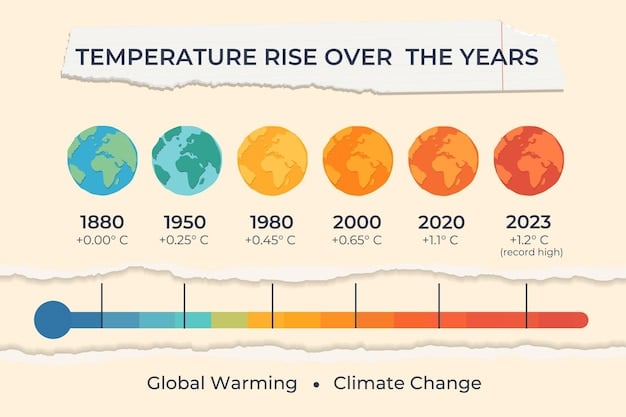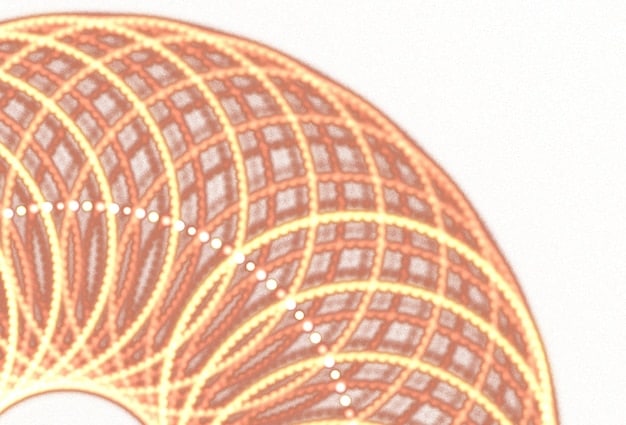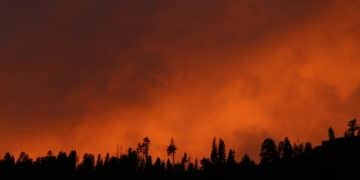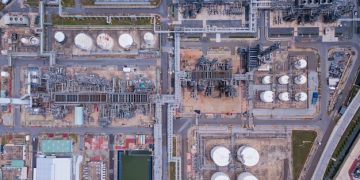Climate Change News: US Heatwaves and the Science Behind Them

Climate change news highlights the increasing frequency of heatwaves in the US, driven by greenhouse gas emissions that trap heat, leading to higher average temperatures and more extreme weather events.
The **climate change news: understanding the science behind the increasing frequency of US heatwaves** is becoming more critical than ever as communities across the nation experience unprecedented temperature spikes. These extreme weather events aren’t random occurrences but are deeply rooted in the escalating effects of climate change.
The Climate Change Connection to US Heatwaves
Climate change acts as a threat multiplier, exacerbating existing weather patterns and leading to more frequent and intense heatwaves across the United States. The underlying mechanisms are rooted in the increased concentration of greenhouse gases in the atmosphere.
Understanding these changes requires looking at both global and local impacts.
Global Temperature Increases
The Earth’s average temperature has been steadily rising due to human activities, primarily the burning of fossil fuels which release carbon dioxide and other greenhouse gases. This warming trend provides a higher baseline for temperatures, making extreme heat more likely.
- Rising Average Temperatures: Global average temperatures have increased by approximately 1 degree Celsius (1.8 degrees Fahrenheit) since the pre-industrial era.
- Greenhouse Gas Emissions: The increase in atmospheric carbon dioxide is primarily due to the burning of fossil fuels for energy and deforestation.
- Polar Ice Melt: Melting polar ice reduces the Earth’s reflectivity, leading to greater absorption of solar radiation and further warming.

Local Weather Patterns
While global warming sets the stage, local weather patterns influence the intensity and duration of heatwaves in specific regions. Changes in atmospheric circulation and jet streams can trap hot air over certain areas, leading to prolonged periods of extreme heat.
Several factors contribute to these regional variations.
- Jet Stream Changes: Alterations in the jet stream can cause high-pressure systems to stall over specific regions, trapping hot air.
- Urban Heat Islands: Cities tend to experience higher temperatures due to the urban heat island effect, where buildings and pavement absorb and retain heat.
- Soil Moisture: Dry soil can exacerbate heatwaves, as less energy is used for evaporation, resulting in higher surface temperatures.
In conclusion, the increasing frequency of heatwaves in the US is directly related to the broader impacts of climate change, with global temperature increases and changes in local weather patterns playing critical roles.
The Science Behind Heatwave Formation
Heatwaves are complex weather phenomena that arise when a combination of atmospheric conditions leads to prolonged periods of abnormally high temperatures. These conditions often involve high-pressure systems and specific atmospheric patterns that trap hot air.
Understanding these mechanisms is crucial for predicting and mitigating the impacts of heatwaves.
High-Pressure Systems and Sinking Air
High-pressure systems play a key role in the formation of heatwaves. Air descends within these systems, compressing and warming as it sinks. This sinking air inhibits cloud formation, allowing more sunlight to reach the ground, further increasing temperatures.
- Atmospheric Stability: High-pressure systems create stable atmospheric conditions, preventing the rise of air that could form cooling clouds.
- Adiabatic Heating: As air descends, it is compressed and warms due to adiabatic processes.
- Clear Skies: The absence of clouds allows for greater solar radiation to heat the surface, leading to higher temperatures.
Atmospheric Blocking Patterns
Atmospheric blocking patterns, such as the “Omega block,” can cause heatwaves to persist for extended periods. These patterns disrupt the normal flow of air, preventing cooler air from moving into the affected region.
These blocking patterns can have devastating consequences.
- Persistent High Pressure: Blocking patterns can cause high-pressure systems to remain stationary, leading to prolonged heatwaves.
- Disrupted Airflow: They prevent the movement of cooler air masses, exacerbating the heat.
- Extreme Weather Events: Blocking patterns can also contribute to other extreme weather events, such as droughts and floods.

In summary, the science behind heatwave formation involves a combination of high-pressure systems, sinking air, and atmospheric blocking patterns that trap hot air and prevent the influx of cooler air, leading to prolonged periods of extreme heat.
Regional Variations in US Heatwaves
While heatwaves are becoming more frequent and intense across the US, the specific impacts vary significantly from region to region. Factors such as geography, climate, and urbanization play a critical role in determining the vulnerability of different areas.
Understanding these regional variations is vital for developing effective adaptation strategies.
The Southwestern United States
The Southwestern US is particularly vulnerable to heatwaves due to its arid climate and high elevation. Cities like Phoenix and Las Vegas have experienced record-breaking temperatures in recent years, with significant impacts on public health and infrastructure.
The challenges in this region are immense.
- Arid Climate: The lack of moisture in the air and soil exacerbates heatwaves.
- Urban Heat Islands: Rapid urbanization has created significant urban heat islands, trapping heat and increasing temperatures.
- Water Scarcity: Heatwaves increase demand for water, straining already limited water resources.
The Eastern Seaboard
The Eastern Seaboard faces a different set of challenges, with heatwaves often accompanied by high humidity. This combination can lead to dangerous heat index values, making it difficult for the body to cool itself.
The impacts are significant in densely populated areas.
- High Humidity: The combination of heat and humidity creates a dangerous environment, increasing the risk of heatstroke.
- Dense Urban Areas: Cities like New York and Boston experience significant urban heat island effects.
- Vulnerable Populations: Elderly and low-income populations are particularly vulnerable to the effects of heatwaves.
In conclusion, regional variations in US heatwaves are driven by factors such as climate, geography, and urbanization, with the Southwestern US facing arid conditions and urban heat islands, while the Eastern Seaboard grapples with high humidity and densely populated areas.
The Impact on Public Health
Heatwaves pose significant risks to public health, leading to a range of heat-related illnesses and increased mortality rates. Vulnerable populations, such as the elderly, children, and those with chronic health conditions, are particularly at risk.
Addressing these health impacts requires a comprehensive approach.
Heat-Related Illnesses
Heatwaves can cause a variety of heat-related illnesses, ranging from mild heat cramps to life-threatening heatstroke. These conditions occur when the body is unable to regulate its temperature effectively.
- Heat Cramps: Muscle spasms caused by dehydration and electrolyte imbalance.
- Heat Exhaustion: A more severe condition characterized by dizziness, nausea, and heavy sweating.
- Heatstroke: A life-threatening condition in which the body’s temperature rises to dangerous levels, leading to organ damage and death.
Mortality Rates
Heatwaves have been linked to increased mortality rates, particularly among vulnerable populations. Studies have shown a significant increase in deaths during periods of extreme heat.
- Elderly: Older adults are more susceptible to heat-related illnesses due to age-related physiological changes.
- Chronic Conditions: Individuals with chronic health conditions, such as heart disease and diabetes, are at higher risk.
- Low-Income Populations: Lack of access to air conditioning and other cooling resources increases vulnerability.
In summary, heatwaves have a profound impact on public health, leading to a range of heat-related illnesses and increased mortality rates, particularly among vulnerable populations such as the elderly, children, and those with chronic health conditions.
Mitigation and Adaptation Strategies
Addressing the increasing frequency and intensity of heatwaves requires a combination of mitigation and adaptation strategies. Mitigation efforts focus on reducing greenhouse gas emissions, while adaptation strategies aim to minimize the impacts of heatwaves.
A multifaceted approach is essential for protecting communities.
Reducing Greenhouse Gas Emissions
The most effective way to mitigate the long-term impacts of heatwaves is to reduce greenhouse gas emissions. This requires a transition to cleaner energy sources and more sustainable practices.
- Renewable Energy: Investing in renewable energy sources, such as solar and wind power, can reduce reliance on fossil fuels.
- Energy Efficiency: Improving energy efficiency in buildings and transportation can lower overall emissions.
- Sustainable Practices: Promoting sustainable land use and agricultural practices can reduce greenhouse gas emissions from these sectors.
Adaptation Strategies
Adaptation strategies are essential for minimizing the immediate impacts of heatwaves. These strategies include improving public health responses, creating cooling centers, and implementing urban planning measures to reduce the urban heat island effect.
- Public Health Responses: Developing heat action plans, providing public education, and ensuring access to cooling resources.
- Cooling Centers: Establishing designated cooling centers where people can seek refuge from the heat.
- Urban Planning: Implementing measures to reduce the urban heat island effect, such as planting trees and using reflective building materials.
In conclusion, mitigating the impacts of heatwaves requires a combination of efforts, including reducing greenhouse gas emissions through renewable energy and sustainable practices, and implementing adaptation strategies such as improving public health responses and urban planning measures.
The Role of Climate Modeling and Prediction
Climate modeling and prediction play a crucial role in understanding and anticipating future heatwave events. These models use complex algorithms and data to simulate the Earth’s climate system and project future temperature trends.
These tools are invaluable for informing policy and preparedness efforts.
Climate Models
Climate models incorporate a wide range of factors, including atmospheric conditions, ocean currents, and land surface processes, to simulate the Earth’s climate system. These models are used to project future temperature trends and the frequency and intensity of extreme weather events.
- Data Integration: Models integrate data from various sources, including satellite observations, ground-based measurements, and historical records.
- Scenario Planning: Models are used to explore different future scenarios based on varying levels of greenhouse gas emissions.
- Regional Projections: Models can provide regional projections of temperature and precipitation changes, helping communities prepare for future impacts.
Prediction and Early Warning Systems
Accurate predictions of heatwaves are essential for enabling timely warnings and effective public health responses. Early warning systems use climate models and real-time weather data to forecast heatwave events.
- Real-Time Monitoring: Monitoring weather conditions and temperature trends in real-time.
- Forecast Accuracy: Improving the accuracy of heatwave forecasts through advanced modeling techniques.
- Public Alerts: Disseminating timely warnings to the public to enable protective measures.
In summary, climate modeling and prediction are essential tools for understanding and anticipating future heatwave events, providing valuable information for informing policy and preparedness efforts, and enabling timely warnings and effective public health responses.
| Key Point | Brief Description |
|---|---|
| 🔥 Rising Temperatures | Global warming increases the frequency and intensity of heatwaves. |
| 🌡️ Public Health Risks | Heatwaves lead to heat-related illnesses and increased mortality. |
| 🌱 Mitigation Strategies | Reducing greenhouse gas emissions is crucial for the long term. |
| 🏙️ Urban Planning | Urban planning can reduce the urban heat island effect through green spaces and reflective surfaces. |
Frequently Asked Questions
▼
The increasing frequency of US heatwaves is primarily driven by climate change, resulting from increased greenhouse gas emissions that trap heat in the atmosphere, leading to higher average temperatures.
▼
High-pressure systems cause air to descend, compress, and warm, inhibiting cloud formation. This allows more sunlight to reach the ground, further increasing temperatures and leading to prolonged heatwaves.
▼
The main health risks include heat-related illnesses such as heat cramps, heat exhaustion, and heatstroke. Vulnerable populations like the elderly and those with chronic conditions are at higher risk of mortality.
▼
Mitigation strategies include transitioning to renewable energy, improving energy efficiency, and implementing sustainable practices to reduce greenhouse gas emissions. Adaptation strategies involve public health responses and urban planning.
▼
Climate models integrate data from various sources to simulate the Earth’s climate system and project future temperature trends. These models help in providing early warnings and informing policy and preparedness efforts.
Conclusion
Understanding the science behind the increasing frequency of US heatwaves is crucial for developing effective mitigation and adaptation strategies. By addressing climate change and implementing measures to protect public health, communities can better prepare for and respond to these extreme weather events.





